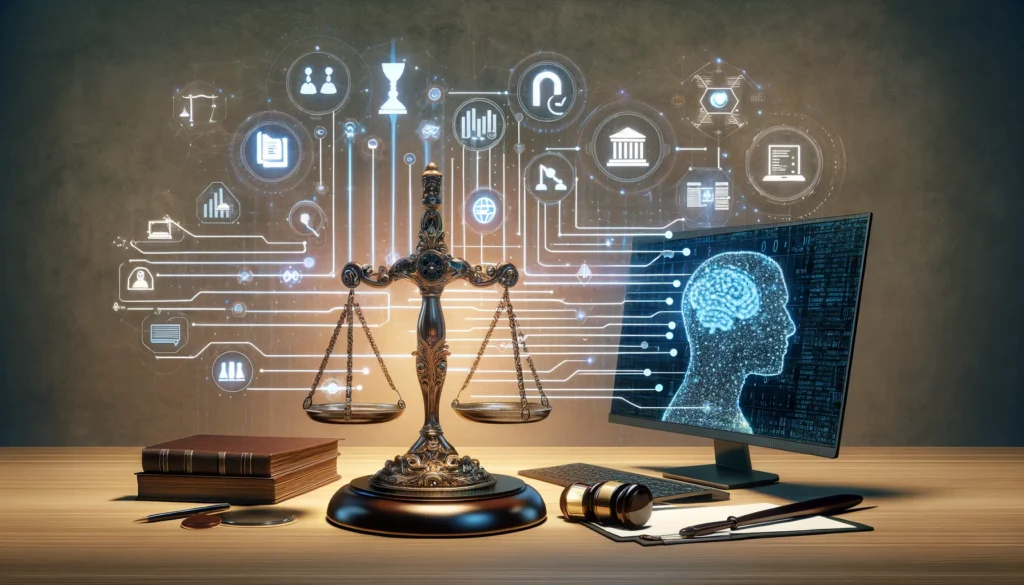
As the legal profession continues to evolve, paralegals and legal professionals are constantly seeking innovative ways to streamline their workflows and stay ahead of the curve. In the realm of corporate compliance documentation, the stakes are high, and the margin for error is slim. With the advent of language models like ChatGPT, a new frontier of possibilities has opened up for legal professionals to revolutionize their approach to compliance documentation.
In this article, we’ll dive into the world of ChatGPT and explore five creative prompts that can help paralegals and legal professionals manage corporate compliance documentation with ease. By leveraging the power of artificial intelligence, legal professionals can free up valuable time and resources, reduce the risk of errors, and focus on high-stakes decision-making.
The Promise of ChatGPT in Compliance Documentation
The potential benefits of using ChatGPT in compliance documentation are vast. From automating routine tasks to providing real-time insights, this technology has the potential to transform the way legal professionals approach compliance documentation. But to unlock its full potential, it’s essential to understand how to craft effective prompts that elicit accurate and relevant responses.
In the following sections, we’ll explore the challenges of corporate compliance documentation, provide a primer on using ChatGPT, and dive into the five best prompts for managing compliance documentation. By the end of this article, you’ll be equipped with the knowledge and tools to harness the power of ChatGPT and take your compliance documentation workflow to the next level.
As we explore the challenges of corporate compliance documentation, it’s essential to understand the complexities and time-consuming nature of this critical task. In the next section, we’ll delve into the pain points and challenges faced by paralegals and legal professionals in managing compliance documentation.
Understanding the Challenges of Corporate Compliance Documentation
As we discussed in the introduction, corporate compliance documentation is a critical task that requires precision, attention to detail, and a deep understanding of regulatory requirements. However, this task is often plagued by complexities, inefficiencies, and risks that can have far-reaching consequences.
The Complexity of Compliance Documentation
Compliance documentation involves navigating a labyrinth of regulations, statutes, and industry standards, which can be overwhelming even for the most experienced legal professionals. The sheer volume of documentation required to ensure compliance can be staggering, and the margin for error is slim. A single misstep can lead to costly fines, reputational damage, and even legal liability.
The Time-Consuming Nature of Compliance Documentation
Compliance documentation is a time-consuming task that can drain valuable resources and divert attention away from high-stakes decision-making. The process of researching, drafting, and reviewing compliance documents can be laborious, and the need for accuracy and consistency adds an extra layer of complexity.
The Risks of Inadequate Compliance Documentation
Inadequate compliance documentation can have severe consequences, including:
- Financial penalties: Non-compliance can result in significant fines and penalties that can cripple a company’s bottom line.
- Reputational damage: Compliance failures can lead to reputational damage, eroding trust and credibility with customers, investors, and stakeholders.
- Legal liability: Inadequate compliance documentation can expose companies to legal liability, leading to costly lawsuits and settlements.
The Need for Innovation in Compliance Documentation
The challenges of corporate compliance documentation are clear, and the need for innovation is pressing. In the next section, we’ll explore how ChatGPT can be leveraged to streamline compliance documentation, reduce risks, and free up valuable time and resources.
As we explore the potential of ChatGPT in compliance documentation, it’s essential to understand the basics of this technology and how it can be harnessed to revolutionize compliance documentation workflows.
Primer on Using ChatGPT for Compliance Documentation
As we’ve discussed, the challenges of corporate compliance documentation are multifaceted and complex. However, with the advent of language models like ChatGPT, a new frontier of possibilities has opened up for legal professionals to revolutionize their approach to compliance documentation.
What is ChatGPT?
ChatGPT is a type of language model that uses artificial intelligence to understand and respond to human input in a conversational manner. This technology has been trained on a massive dataset of text from the internet and can generate human-like responses to a wide range of prompts and questions.
How Can ChatGPT Be Used for Compliance Documentation?
ChatGPT can be used in various ways to streamline compliance documentation, including:
- Data extraction: ChatGPT can be used to extract relevant information from large datasets, such as regulatory updates, industry reports, and company policies.
- Document generation: ChatGPT can be used to generate compliance documents, such as policies, procedures, and reports, based on specific templates and prompts.
- Review and analysis: ChatGPT can be used to review and analyze compliance documents, identifying potential errors, inconsistencies, and areas for improvement.
Getting Started with ChatGPT
To get started with ChatGPT, legal professionals can follow these simple steps:
- Create an account: Sign up for a ChatGPT account and familiarize yourself with the platform.
- Understand the basics of prompt engineering: Learn how to craft effective prompts that elicit accurate and relevant responses from ChatGPT.
- Experiment with different use cases: Start experimenting with different use cases, such as data extraction, document generation, and review and analysis.
The Potential of ChatGPT in Compliance Documentation
The potential benefits of using ChatGPT in compliance documentation are vast. By automating routine tasks, reducing the risk of errors, and freeing up valuable time and resources, legal professionals can focus on high-stakes decision-making and strategic planning.
With a solid understanding of ChatGPT and its capabilities, we can now explore the five best prompts for managing corporate compliance documentation. In the next section, we’ll dive into the specifics of each prompt and provide examples of how they can be used in real-world scenarios.
The 5 Best ChatGPT Prompts for Managing Corporate Compliance Documentation
Now that we’ve explored the basics of ChatGPT and its capabilities, let’s dive into the five best prompts for managing corporate compliance documentation. These prompts are designed to help legal professionals streamline their compliance documentation workflows, reduce the risk of errors, and free up valuable time and resources.
Prompt 1: Generate a Comprehensive Compliance Checklist
- Prompt: “Create a comprehensive compliance checklist for [specific industry/region] that includes all relevant regulations, statutes, and industry standards.”
- Example: “Create a comprehensive compliance checklist for the financial services industry in the United States that includes all relevant regulations, statutes, and industry standards.”
Prompt 2: Create a Template for Compliance Documents
- Prompt: “Develop a template for [specific compliance document type, e.g. conflict of interest policy] that includes all required elements and meets industry standards.”
- Example: “Develop a template for a conflict of interest policy that includes all required elements and meets industry standards for the healthcare industry.”
Prompt 3: Summarize Key Points of Regulatory Updates
- Prompt: “Summarize the key points of [recent regulatory update] and provide an action plan for implementation.”
- Example: “Summarize the key points of the recent GDPR update and provide an action plan for implementation in the European Union.”
Prompt 4: Analyze Compliance Documents
- Prompt: “Analyze [sample compliance document] and provide suggestions for improvement, including areas of non-compliance and potential risks.”
- Example: “Analyze this conflict of interest policy and provide suggestions for improvement, including areas of non-compliance and potential risks.”
Prompt 5: Develop a Workflow for Tracking and Managing Compliance Documentation
- Prompt: “Develop a workflow for tracking and managing compliance documentation, including deadlines and responsible parties.”
- Example: “Develop a workflow for tracking and managing compliance documentation for the financial services industry, including deadlines and responsible parties.”
The Power of ChatGPT in Compliance Documentation
These five prompts demonstrate the power of ChatGPT in compliance documentation. By leveraging these prompts, legal professionals can streamline their compliance documentation workflows, reduce the risk of errors, and free up valuable time and resources.
As we’ve seen, ChatGPT can be a powerful tool in compliance documentation. In the next section, we’ll explore advanced techniques for getting the most out of ChatGPT, including tips for crafting effective prompts and fine-tuning responses.
Advanced Techniques for Getting the Most Out of ChatGPT
As we’ve explored the five best prompts for managing corporate compliance documentation, it’s essential to delve deeper into advanced techniques for getting the most out of ChatGPT. By mastering these techniques, legal professionals can unlock the full potential of ChatGPT and take their compliance documentation workflows to the next level.
Crafting Effective Prompts
Crafting effective prompts is crucial to getting accurate and relevant responses from ChatGPT. Here are some tips for crafting effective prompts:
- Be specific: Provide specific details about the task or question you want ChatGPT to answer.
- Use clear language: Avoid using ambiguous language or jargon that ChatGPT may not understand.
- Define key terms: Define key terms and concepts to ensure ChatGPT understands the context.
Fine-Tuning Responses
Fine-tuning responses is essential to getting accurate and relevant results from ChatGPT. Here are some tips for fine-tuning responses:
- Use feedback loops: Provide feedback to ChatGPT on its responses to refine its understanding and improve accuracy.
- Iterative refinement: Refine your prompts and responses through iterative refinement to get more accurate results.
Integrating ChatGPT with Other Tools and Workflows
To maximize the benefits of ChatGPT, it’s essential to integrate it with other tools and workflows. Here are some tips for integrating ChatGPT:
- API integration: Integrate ChatGPT with other tools and systems using APIs to automate workflows.
- Workflow automation: Automate workflows by integrating ChatGPT with other tools and systems.
The Future of Compliance Documentation
As we’ve explored the advanced techniques for getting the most out of ChatGPT, it’s clear that this technology has the potential to revolutionize compliance documentation. By leveraging ChatGPT, legal professionals can streamline their compliance documentation workflows, reduce the risk of errors, and free up valuable time and resources.
As we conclude our exploration of ChatGPT in compliance documentation, it’s essential to reflect on the benefits and limitations of this technology. In the next section, we’ll explore the future of compliance documentation and the role of LLMs in shaping it.
From Automation to Augmentation: Unlocking the Full Potential of ChatGPT in Compliance Documentation
As we conclude our exploration of ChatGPT in compliance documentation, it’s essential to reflect on the benefits and limitations of this technology. While ChatGPT has the potential to revolutionize compliance documentation, it’s crucial to recognize its limitations and potential biases.
The Benefits of ChatGPT in Compliance Documentation
ChatGPT has the potential to streamline compliance documentation workflows, reduce the risk of errors, and free up valuable time and resources. By automating routine tasks and providing real-time insights, ChatGPT can help legal professionals focus on high-stakes decision-making and strategic planning.
The Limitations of ChatGPT in Compliance Documentation
While ChatGPT has the potential to revolutionize compliance documentation, it’s essential to recognize its limitations and potential biases. ChatGPT is only as good as the data it’s trained on, and it may not always understand the nuances and complexities of compliance documentation.
The Future of Compliance Documentation
As we look to the future of compliance documentation, it’s clear that ChatGPT and other LLMs will play a critical role in shaping the industry. By leveraging the power of AI and machine learning, legal professionals can streamline their compliance documentation workflows, reduce the risk of errors, and free up valuable time and resources.
Conclusion: Unlocking the Full Potential of ChatGPT in Compliance Documentation
In conclusion, ChatGPT has the potential to revolutionize compliance documentation by automating routine tasks, providing real-time insights, and freeing up valuable time and resources. By leveraging the power of AI and machine learning, legal professionals can unlock the full potential of ChatGPT and take their compliance documentation workflows to the next level.
Final Thoughts
As we conclude our exploration of ChatGPT in compliance documentation, it’s essential to remember that this technology is only as good as the data it’s trained on and the prompts it receives. By crafting effective prompts and fine-tuning responses, legal professionals can unlock the full potential of ChatGPT and take their compliance documentation workflows to the next level.


